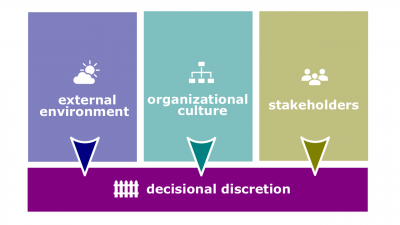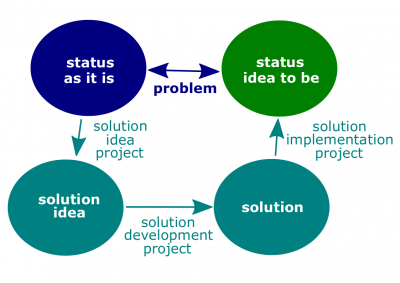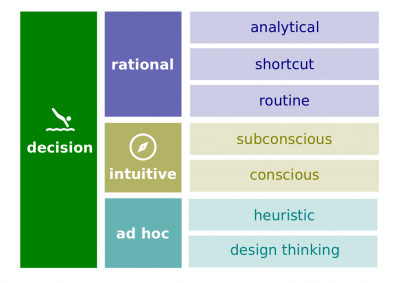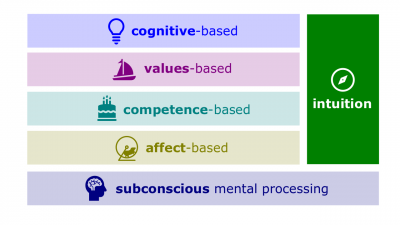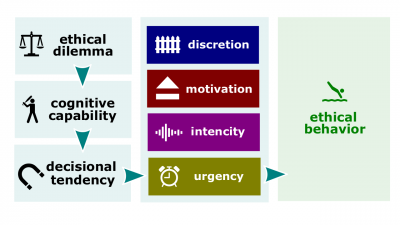Decision-making
Decision-making (alternatively spelled, decision making) is the action, process, and/or creative behavior of making decisions.
Contents
Decisions
Any decision is a choice made from among two or more alternatives. The criteria that define what's important or relevant to resolving a problem are known as decision criteria. The freedom to decide what should be done in a particular situation is known as decisional discretion.
Programmed vs non-programmed
- Programmed decision. Any decision to follow a policy, operative rule, another regulation, or to routinely repeat one's previous decision that has been made while handling a similarly structured task.
- Non-programmed decision (creative decision). A unique and nonrecurring decision that requires a custom-made solution.
Individual vs collective
- Individual decision-making. Decision-making made by an individual as opposed to group decision-making.
- Group decision-making. Decision-making made by a group as opposed to individual decision-making.
Significant vs sounding
- Some decisions are made to solve significant problems; the opposite extreme may be referred as sounding board.
Tasks
Those decisions that shall be made to execute a particular job task may or may not adapt to various task attributes such as consequence of error, impact on enterprise, importance of being accurate, level of competition, task structure, virtualization, and others.
Structured vs unstructured
- Task structure. One of Fiedler's situational contingencies that describes the degree to which job assignments are formalized and structured.
- Structured task. The job task that is well-defined and which parts are organized in the way that they relate well to each other.
- Unstructured task. The job task that is ambiguous and which parts are needed to be discovered, researched, understood, and/or organized in the way that they would relate well to each other.
Error-untenable vs error-tolerant
- Consequence of error. How serious would the result usually be if the worker made a mistake that was not readily correctable?
Competitive vs non-competitive
- Level of competition. To what extent does this job require the worker to compete or to be aware of competitive pressures?
Impactful vs non-influential
- Impact on enterprise. What results do your decisions usually have on other people or the image or reputation or financial resources of your employer?
Factors
Environmental factors may influence the decision-making process.
Forcing vs backgrounding
- Some factors such as regulatory compliance are mandatory; some such as weather are on the background of the decision-making process.
Controlled vs uncontrolled
- Situational control. The capacity of a decision maker to manage the situation and estimate the likelihood of certain outcomes.
- Certainty. A situation in which a decision maker can make accurate decisions because all the data and outcomes are known.
- Uncertainty. A situation in which a decision maker has neither certainty nor reasonable probability estimates available.
Internal vs external
- Both internal and external factors contribute to the quality of decision-making.
- The internal factors may include core self-evaluation, decisional tendency, general mental ability, personal values and beliefs, as well as emotions and moods of the decision maker.
- The external factors may include natural forces such as time of the day and day of the week when decision-making takes place, as well as cultural, economic, social, and political forces.
Resources
Decision-making may involve costs. Sufficiency of data, time, adequacy of techniques and tools, as well as enterprise competence of the decision maker impact the quality of decisions.
Sufficient vs deficient data
- Any decision is based on data. The deficiency of that data may impact the quality of decision-making and its outcomes.
Tools and techniques
- As a part of one's enterprise competence, decision maker's capacity to utilize various techniques and tools may impact the quality of decision-making. The complex decisions may require advanced tools such as an enterprise resource planning ecosystem (ERP ecosystem) and/or other tools. Thus, accessibility of tools and resources may play its role as well.
Time-pressing vs time-insensitive
- Time availability varies. Time pressure refers to how often the job task requires the worker to meet strict deadlines. How important is it to this job that the pace is determined by the speed of equipment or machinery? (This does not refer to keeping busy at all times on this job.)
Approaches
Decision-making approach. A particular manner of taking preliminary steps toward making a decision.
Rational
- Rational decision-making. Decision-making that produces choices that are logical and consistent and maximize value.
- Rationale. A reasoning characterized by making consistent, value-maximizing choices within specified constraints.
- Rational decision-making model. A decision-making model that describes how individuals may rationally behave in order to maximize the outcomes from the decision.
DREPD GOFER DECIDE Seven-step decision-making Discover Goals clarification. Define the problem. Outline your goal and outcome. Establish all the criteria (constraints). Gather data. Options generation. Develop alternatives. Research Facts-finding. Consider all the alternatives. Consideration of Effects List pros and cons of each alternative. Envision Review and implementation. Identify the best alternative. Make the decision. Plan Develop and implement a plan of action Immediately take action to implement it. Do and discover again Evaluate and monitor the solution and examine feedback when necessary Learn from and reflect on the decision. - Seven-step decision-making. A rational decision-making model that consists of seven steps.
Intuitive
- Intuitive decision-making. Unconscious decision-making on the basis of distilled experience, feelings, and accumulated judgment.
- Intuition. An instinctive feeling not necessarily supported by research.
Ad hoc
- Ad hoc decision-making. Decision-making that happens only for a particular purpose or need, not planned before it happens.
- Design thinking. Approaching management problems as designers approach design problems.
- Heuristic. A rule of thumb that decision makers use to simplify decision-making.
Strategies
Optimizing vs. satisficing
- Decision-making optimization. The strategy that strives to choose the most feasible solution or alternative to the problem from among the list of possible alternatives, while taking into consideration the nature of the decision and its job task, environmental factors, resources, and decision-making dilemmas.
- Satisfice. Acceptance of solutions that are "good enough." The term, satisficing, came from the combination of "satisfactory" and "sufficient." This strategy is done by choosing the first satisfactory option over the best alternative.
Conservative vs aggressive
- Allostasis. Working to change behavior and attitude to find stability.
- Risk aversion. The tendency to prefer a sure gain of a moderate amount over a riskier outcome, even if the riskier outcome might have a higher expected payoff.
- Maximax (maximize the maximums). A decision-making strategy that openly takes risks because the approach is choosing the alternatives based on their highest potentials and most favorable outcomes.
- Maximin (maximize the minimums). In contrast to the maximax strategy, the decision maker settles for the alternative with the highest minimum payoff for failures or negative outcomes.
Process types
Linear vs nonlinear
Agile vs rigid
Thorough vs shortcut
- Bounded rationality. Decision-making that is rational, but limited (bounded) by an individual's ability to process information. In other words, bounded rationality is a process of making decisions by constructing simplified models that extract the essential features from problems without capturing all their complexity.
- Escalation of commitment. An increased commitment to a previous decision despite evidence it may have been wrong.
Considerations
Decision-making dilemma. Optimizing vs. satisficing, intuitive vs rational vs ad hoc, Agile vs rigid, conservative vs aggressive, linear vs nonlinear
Self-regulation
- Self-regulation strategy.
- Prevention focus. A self-regulation strategy that involves striving for goals by fulfilling duties and obligations.
- Promotion focus. A self-regulation strategy that involves striving for goals through advancement and accomplishment.
Ethics
- Ethical dilemma. A situation in which individuals are required to define right and wrong conduct.
- Ethics. Principles, values, and beliefs that define what is right and wrong behavior.
- Behavioral ethics. Analyzing how people actually behave when confronted with ethical dilemmas.
